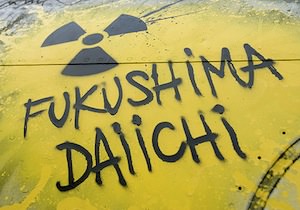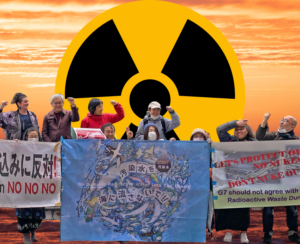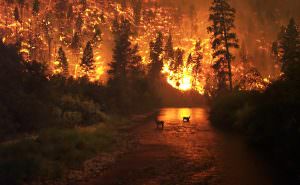Experts Fear Fukushima Leaks Sending Radioactive Water Into the Pacific
The radiation crisis at the melted-down Fukushima power plant is worsening as leaking tanks and underground water add new and critical problems that some fear are beyond the Tokyo Electric Power Company's ability to handle.
In what feels like a surreal game of “can you top this,” nuclear experts say they fear highly radioactive water deep beneath Japan’s tsunami-ravaged Fukushima nuclear plant is creeping closer to the Pacific, and may already be sending unknown amounts of tainted water into the sea.
The revelation, reported by The Associated Press, comes just days after the Tokyo Electric Power Company acknowledged that above-ground storage tanks have been leaking tens of thousands of gallons of radioactive water into the ground. Most galling to nuclear activists has been TEPCO’s lack of transparency about the problems at the plant ever since the 2011 earthquake and tsunami led three reactors to melt down, and the company’s apparent failure to anticipate what seem like fairly obvious potential problems — such as leaking tanks.
“I don’t know if describing it this way is appropriate, but it’s like a haunted house and, as I’ve said, mishaps keep happening one after the other,” Shunichi Tanaka, Japan’s top nuclear regulator, said at a news conference before the below-ground leaks were discovered. “We have to look into how we can reduce the risks and how to prevent it from becoming a fatal or serious incident.”
The International Atomic Energy Agency says it has been monitoring the situation, and the Chinese foreign ministry said in a statement that it was “shocked” at the leak problems and urged the Japanese government to “take effective steps to put an end to the negative impact of the after-effects of the Fukushima nuclear accident.” Japanese government officials were similarly concerned about what it called the “deplorable” chain of events, and Japan’s Nuclear Regulation Authority raised questions about whether TEPCO was capable of straightening out the mess.
At issue is water used to continue cooling the radioactive cores, according to the AP:
To keep the melted nuclear fuel from overheating, TEPCO has rigged a makeshift system of pipes and hoses to funnel water into the broken reactors. The radioactive water is then treated and stored in the aboveground tanks that have now developed leaks. But far more leaks into the reactor basements during the cooling process — then through cracks into the surrounding earth and groundwater.
About 1,000 tons of underground water from the mountains flows into the plant compound each day, of which 400 tons seep into the reactor and turbine basements and get contaminated. The remaining 600 avoids that area, but at least half of it is believed to eventually come in contact with contamination elsewhere before entering the sea, according to an estimate by Japan’s Agency for Natural Resources and Energy.
Scientists, pointing to stubbornly high radioactive cesium levels in bottom-dwelling fish since the disaster, had for some time suspected the plant was leaking radioactive water into the ocean. TEPCO repeatedly denied that until last month, when it acknowledged contaminated water has been leaking into the ocean from early in the crisis.
The lack of details provided by TEPCO has frustrated scientists trying to understand the breadth of the problem. But even what is known has alarmed experts, such as Mycle Schneider, an international consultant on nuclear issues and lead author for the World Nuclear Industry Status Report.
“The quantities of water they are dealing with are absolutely gigantic,” Schneider told the BBC last week. “What is the worse is the water leakage everywhere else — not just from the tanks. It is leaking out from the basements, it is leaking out from the cracks all over the place. Nobody can measure that. … It is much worse than we have been led to believe, much worse.”
—Posted by Scott Martelle.
Your support matters…Independent journalism is under threat and overshadowed by heavily funded mainstream media.
You can help level the playing field. Become a member.
Your tax-deductible contribution keeps us digging beneath the headlines to give you thought-provoking, investigative reporting and analysis that unearths what's really happening- without compromise.
Give today to support our courageous, independent journalists.






You need to be a supporter to comment.
There are currently no responses to this article.
Be the first to respond.